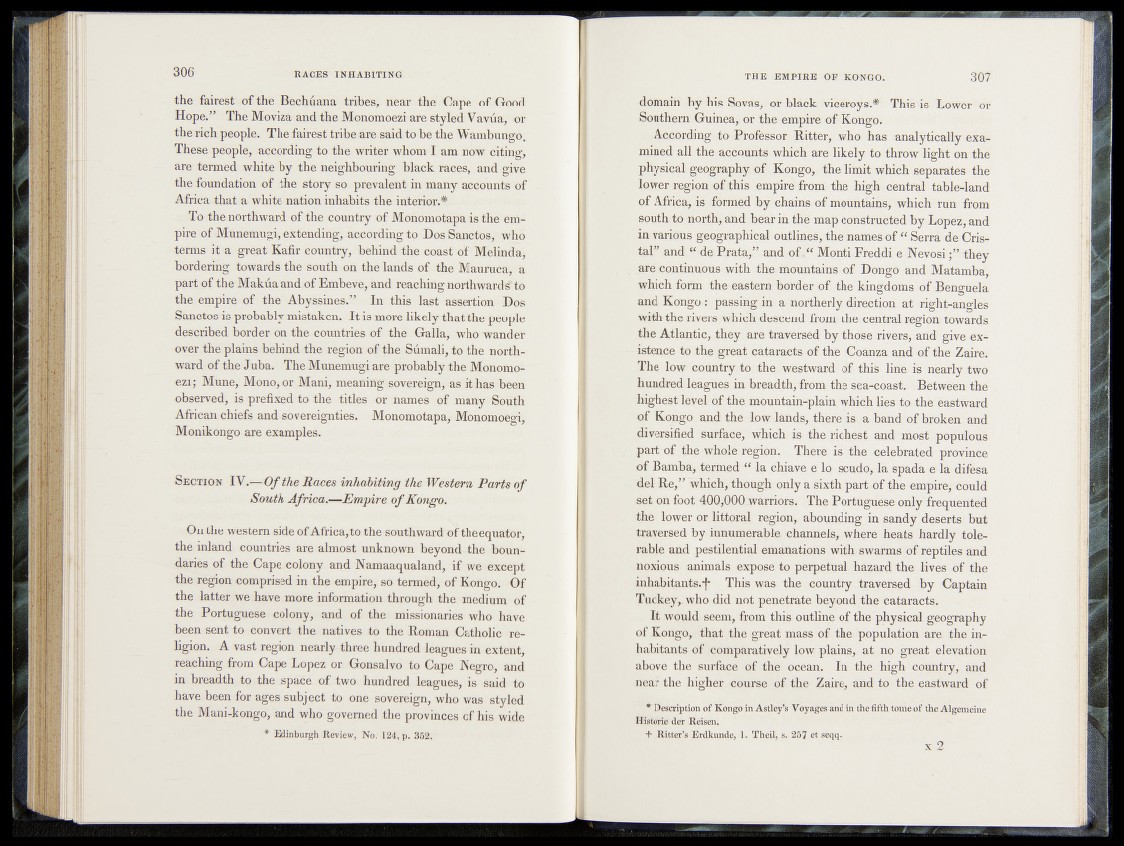
the fairest of the Bechuana tribes, near the Cape of Good
Hope.” The Moviza and the Monomoezi are styled Vavua, or
the rich people. The fairest tribe are said to be the Wambungo.
These people, according to the writer whom I am now citing,
are termed white by the neighbouring black races, and give
the foundation of the story so prevalent in many accounts of
Africa that a white nation inhabits the interior.*
To the northward of the country of Monomotapa is the empire
of Munemugi, extending, according to DosSanctos, who
terms it a great Kafir country, behind the coast of Melinda,
bordering towards the south on the lands of the Mauruca, a
part of the Makua and of Embeve, and reaching northward# to
Bie empire of the Abyssines.” In this last assertion Bos
Sanctos is probably mistaken. It is more likelythat the people
described border on the countries of the Galla, who wander
over the plains behind the region of $he Sumali, to the northward
of the Juba. The Munemugi are probably the Monomoezi;
Mune, Mono, or Mani, meaning sovereign, as'it has been
observed, is prefixed to the titles or names of many South
African chiefs and sovereignties. Monomotapa, Monomoegi,
Monikongo are examples.
S ection IV.—Of the Races inhabiting the Western Parts of
South Africa.—Empire of Kongo.
On the western side of Africa,to the southward of the equator,
the inland countries are almost unknown beyondthe boundaries
of the Cape colony and Namaaqualand, if we except
the region comprised in the empire, so termed, of Kongo. Of
the latter we have more information through the medium of
the Portuguese colony, and of the missionaries who have
been sent to convert the natives to the Roman Catholic religion.
A vast region nearly three hundred leagues in extent,
reaching from Cape Lopez or Gonsalvo to Cape Negro, and
in breadth to the space of two hundred leagues, is said to
have been for ages subject to one sovereign, who was styled
the Mani-kongo, and who governed the provinces of his wide
* Edinburgh Review, No. 124, p. 352.
domain by his Sovds, or black viceroys.* This is Lower or
Southern Guinea, or the empire of Kongo.
According to Professor Ritter, who has analytically examined
all the accounts which are likely to throw light on the
physical geography of Kongo, the limit which separates the
lower region of this empire from the high central table-land
of Africa, is formed by chains of mountains, which run from
south to north, and bear in the map constructed by Lopez, and
in various geographical outlines, the names of “ Serra de Cris-
tal” and “ de Prata,” and of.“ Monti Freddi e Nev o sith ey
are continuous with the mountains of Dong# and Matamba,
which form the eastern border of the kingdoms of Benguela
and Kongo : passing in a northerly direction at right-angles
with the rivers which descend from the central region towards
the Atlantic, they are traversed by those rivers, and give existence
to the great cataracts of the Coanza and of the Zaire.
The low country to the, westward of this line is nearly two
hundred leagues in breadth, from the sca^coast. Between the
highest level of the mountain-plain which lies to the eastward
of Kongo and the low lands, there is a band of broken and
diversified surface, which is the richest and most populous
part of the whole region. There is the celebrated province
of Bamba, termed “ la chiave e lo scudo, la spada e la difesa
del Re,” which, though only a sixth part of the empire, could
set on foot 400,000 warriors. The Portuguese only frequented
the lower or littoral region, abounding in sandy deserts but
traversed by innumerable channels, where heats hardly tolerable
and pestilential emanations with swarms of reptiles and
noxious animals expose to perpetual hazard the lives of the
inhabitants.*!* This was the country traversed by Captain
Tuckey,who did not penetrate beyond the cataracts.
It would seem, from this outline of the physical geography
of Kongo, that the great mass of the population are, the inhabitants
of comparatively low plains, at no great elevation
above the surface of the ocean. In the high country, and
near the higher course of the Zaire, and to the eastward of
•"Description of Kongo in Astley’s Voyages and in the fifth tome of the Algemeine
Historie der Reisen.
4* Ritter’s Erdkunde, 1. Theil, s. 257 et seqq.
x 2